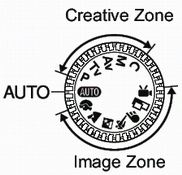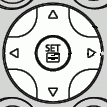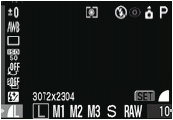You can change the resolution and compression (excluding movies) settings to suit the purpose of the image you are about to shoot.To record the CCD output without compression, select the RAW file format.
Changing the Resolution and Compression
Shooting in RAW format
About RAW format
|
Resolution
|
Purpose
|
|
L or RAW (Large) 3072 X 2304 pixels
|
Print A4 size 210 x 297 mm (8.3 x 11.7 in.) or larger prints
Print letter size 216 x 279 mm (8.5 x 11 in.) or larger prints
|
| M1 (Medium 1) 2592 X 1944 pixels |
Print A4 size 210 x 297 mm (8.3 x 11.7 in.) or larger prints
Print letter size 216 x 279 mm (8.5 x 11 in.) or larger prints
|
|
M2 (Medium 2) 2048 X 1536 pixels
|
Print A4 size 210 x 297 mm (8.3 x 11.7 in.) prints
Print letter size 216 x 279 mm (8.5 x 11 in.) prints
|
|
M3 (Medium 3) 1600 X 1200 pixels
|
Print postcard size 148 x 100 mm (6 x 4 in.) prints
Print L size 119 x 89 mm (4.7 x 3.5 in.) prints
|
|
S (Small) 640 X 480 pixels
|
Send images as e-mail attachments
Shoot more images
|
|
Compression
|
Purpose
|
 Superfine Superfine |
Shoot higher quality images |
 Fine Fine |
Shoot normal quality images |
 Normal Normal |
Shoot more images |
Movies can be shot with the following resolution.
|
Resolution
|
Purpose
|
 640 X 480 pixels 640 X 480 pixels |
Shoot higher quality movies |
 320 X 240 pixels 320 X 240 pixels |
Shoot normal quality movies |
 160 X 120 pixels 160 X 120 pixels |
Shoot smaller file size movies |
Changing the Resolution and Compression
1. Turn the shooting mode dial to the desired Shooting mode.

2. Press the <FUNC.> button.

3. Select L* using the  or
or  button on the omni selector.
button on the omni selector.


* The current setting is displayed.
4. Select the resolution you wish to set using the  or
or  button. (Excluding
button. (Excluding  )
)
5. Press the <SET> button.
6. Select the compression you wish to set using the  or
or  button.
button.

You can shoot the image right after selecting settings by pressing the shutter button. This screen will appear again, once the image is shot.
7. Press the <FUNC.> button.
8. Shoot the image.

- Some settings are not available with certain Shooting modes.
Shooting in RAW format
RAW is only available in the P, Tv, Av, and M modes
The recording file format can be switched to the RAW format before shooting the image.
When shooting in the RAW format, you can obtain images of the same high quality as those in uncompressed files.
If the RAW format is selected when the compression is set to  (Normal), the resolution for each image will be fixed at 3072 x 2304.
(Normal), the resolution for each image will be fixed at 3072 x 2304.

- It is possible to select the resolution for JPEG thumbnails contained within RAW format image files. This is useful when displaying enlarged RAW-format images with the camera, or when checking either the focus or for camera shake.
- Images shot in the JPEG format can also be changed to the RAW format while they are displayed right after shooting.
|
About RAW format
With the standard JPEG file format, the camera processes images after capturing them to produce optimal results. The JPEG format compresses images so that more can be stored on a single CF card. However, the compression is irreversible, meaning that the original image data cannot be recovered after processing. In contrast, the RAW format records the image data as captured by the camera's CCD without further processing. RAW images are compressed, but the compression is reversible so that a high-quality image can be obtained from the decompressed file without any loss of image quality. In addition, although a RAW file is larger than an equivalent JPEG file, it is still only approximately one-quarter the size of an uncompressed RGB TIFF format file, making it relatively compact.
With standard uncompressed file formats, such as RGB TIFF, images are processed in the camera and require further processing by image editing software to adjust the image parameters, which reduces image quality. Since RAW images cannot be opened by many image editing programs, it is necessary to convert them to standard image file formats, such as TIFF or JPEG. By using ZoomBrowser EX (Windows)or ImageBrowser (Macintosh), which are included with the camera, you can make fine adjustments to the image quality and coloration when the images are converted, while maintaining the high quality of the original image data. For further details, please refer to the Software Starter Guide supplied with your camera.